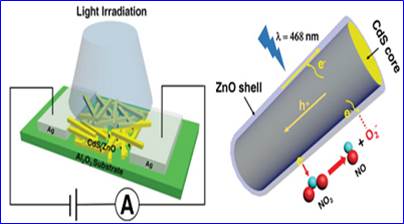One-dimensional heterojunction nanostructures have been extensively studied over recent years due to their great potential in improving semiconductor-based device technologies, including photodetectors, and gas sensors. Core/shell nanowires that consist of two components with distinct functionality are ideal building blocks for nanoscale photodetectors and gas sensors. CdS nanostructures have been synthesized and fabricated into photodetectors with excellent performance in the visible-light region, while ZnO is widely used as the gas-sensing material. As a result, the fabrication of CdS/ZnO core/shell nanowires and research on optoelectronic enhanced gas-sensing have the significance to develop optoelectronic gas sensor.
For the first time, researchers of Xinjiang Technical Institute of Physics & Chemistry (XTIPC) synthesized CdS/ZnO core/shell nanowires, which can combine both the advantages of CdS and ZnO and significantly enhance the photodetecting and optoelectronic gas-sensing performances. The corresponding photodetector exhibited a fast, reversible, and stable optoelectronic response with a rise time of ∼26 ms, a decay time of ∼2.1 ms, which was superior to similar photodetector. The corresponding gas sensor also showed an excellent visible-light-activated gas sensing performance at room temperature with a detecting limit of 5 ppb. Researchers found that the sensitivity of the sensor was dependent on the illuminated light intensity with a maximum value. The present CdS/ZnO core/shell nanowire not only benefits the fabrication of efficient photodetectors, but also makes the instant, optically controlled sensing of ppb-level NO2 gas possible.
The results of this study have been published online on Advanced Optical Materials. This work was supported by National Natural Science Foundation of China, the “One Hundred Talents” program of CAS, the International Scientific Cooperation Program of Xinjiang etc.

Schematic diagram of a photodetector constructed from CdS/ZnO core/shell nanowires (Image by XTIPC )
